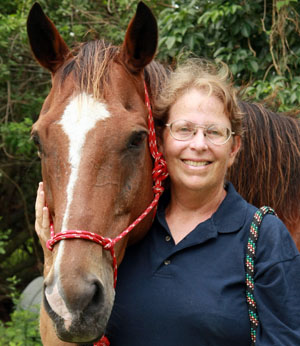TALES FROM THE TRAILS
The weather report had called for rain, but luckily for all, Saturday night, Jan. 10, remained clear and cool. The stands at the Palm Beach International Equestrian Center were crammed with nearly 4,000 spectators, including many families, young children and dogs. The jumps were set, and the horses and riders more than ready to begin the $75,000 Battle of the Sexes. Would the women win again, as they had the past six years?
Ten men and 10 women, wearing blue and pink polo shirts (respectively), battled it out head to head, the two teams vying for top honors. Candice King captained the women’s team of Erynn Ballard, Nicole Bellissimo, Amanda Derbyshire, Margie Engle, Abigail McArdle, Catherine Pasmore, Alison Robitaille, Debbie Stephens and Kelsey Thatcher.
Charlie Jayne led the men. His team also included David Beisel, David Blake, Daniel Bluman, Mark Bluman, Alex Granato, Angel Karolyi, Darragh Kenny, Samuel Parot and Andrew Ramsay.
The three-phase competition got underway at 7 p.m. with the speed round. Debbie Stephens rode out first on Swagger, a lovely gray. The horn sounded, and she was off, trying to go fast and clear. The first two lines were long and straight, but the rest of the course zigged and zagged, requiring a land and turn, land and turn. Debbie made it through clear in 60.74 seconds. Darragh Kenny followed, also going clear in a faster 56.61 to win the first point for his team.
And so it went, alternating sexes, each woman paired against a man, some clear, some with jumping and/or time faults, even a couple of refusals when the riders tried to shave off a few seconds by turning a little too tight. The crowd cheered as each rider tried to outdo his or her partner.
The last four men to ride had the fastest clear times: Samuel Parot at 55.52, Mark Bluman at 56.43, Andrew Ramsay at 54.32 and Alex Granato, who flew around on Zenith Dance, another amazing gray, in a blazing 52.77. The men won that round, 6-4.
The only slightly annoying part of the evening was the announcing. Although there was constant commentary, the acoustics were poor, which made most of it unintelligible. The Jumbotrons in each corner, however, depicted each rider’s time and faults.
There was a 20-minute break while the course was reconfigured. Crazy fast tractors zoomed around, dragging the arena dirt. Ground crews dismantled and rebuilt jumps. A live band played, and kids danced to the music, some of them showing up on the Jumbotron. Fire jugglers and tall ladder walkers entertained the crowds ringside.
Back along the shop area, there was tasty food and a variety of goods to be examined, including stuffed ride-on ponies that rolled. For the kids, there was a pair of live minis to be petted, the carousel, and other games and rides. If you had kids, or just enjoyed watching them, this was a very good place to be.
Finally, the second phase, and in my opinion, the most fascinating one, began: the side-by-side match race. The arena now held two identical courses. Two riders approached a man holding a red flag, and when he waved it, they turned and raced over the fences, each one again aiming for fastest clear round.
Of any class offered at the Winter Equestrian Festival, this one lets you really see how diverse riding styles can make the difference between winning and placing. We watched as these elite riders started from the same point, jumping identical courses in real time, and yet, within the first seconds, one was slightly ahead, and by the end of the round, one was often ahead by a lot. The men won some, the women won some, but I didn’t care about that. I was mesmerized by how those tight turns made all the difference.
And there was a chance for the riders to have some fun with each other. As the ninth pair rode, Mark Bluman knew he’d never beat out Abigail McArdle, so he abandoned his course and rode over to her side, darting in front of her as she headed for the last jump. It didn’t work, and she finished clear. In the end, the men won once more, 6-4, making the team totals 12-8.
More tractors, more entertainment and the jumps vanished. Last came the six-bar competition to determine the ultimate winner. Six jumps marched in a diagonal line down the center, two strides between each one. The starting height was 5-foot-3, and four riders from each team took turns trying only to go clear and win the right to come back and jump again. Mark Bluman rode first and had the last rail down, followed by Candace King, Samuel Parot and Nicole Bellissimo, who were all clear. David Beisel rode next, going clear as well and somehow making it look easy. It wasn’t, and the next rider, Kelsey Thatcher, had four rails down. Alex Granato and Alison Robitaille also went clear.
The last two fences were raised, and the riders returned. Alison had the only clear ride, so she alone jumped two more clear rounds over a shortened, four-jump course to earn more points. The last fence was set at 5-foot-9.
With the two teams tied at 18 points, one rider from each came back to try the four jumps, the final one raised to a height of 6 feet. Alex Granato rode for the men and Candice King for the women, but both dropped a rail at the final jump. The team captains briefly deliberated and decided to let the class end in a tie.
The audience didn’t seem to mind. They stamped, applauded and whistled. It had been an exciting competition.
To watch some of the action, visit the WEF Facebook page at www.facebook.com/winterequestrianfestival.








